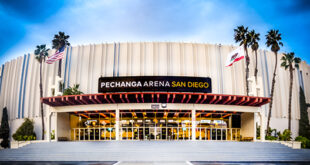The town has attracted much retail during the past year, and there’s more on the way, but it’s not alone. A lot of retailers are liking the High Desert more and more.
The High Desert is undergoing a retail renaissance, and Apple Valley is helping to lead the charge.
During the past year, Subway, Juice It Up, Fat Jack’s Bar & Grill, Fantastic Sam’s, T-Mobile, Guiseppe’s Italian Restaurant and Spirit River Cafe have all opened locations in Apple Valley, said Orlando Acevedo, the town’s economic development manager.
By far the most activity has happened at Jess Ranch Marketplace, the 960,000-square-foot regional shopping center at Bear Valley Road and Jess Ranch Parkway that opened its third and most recent phase in 2009.
OshKosh B’Gosh and Carter’s Children’s Clothing recently opened their first Victor Valley stores there, along with Beauty and Jersey Mike’s Subs, the popular sandwich store chain.
“2013 was probably the best year we’ve had for retail growth in the last seven years,” Acevedo said. “There’s a lot of pent-up demand in this market.”
Jess Ranch Marketplace, which already has Best Buy, Bed Bath & Beyond, PetSmart, Famous Footwear and 24 Hour Fitness on its list of tenants, is now about 90 percent leased and still has room for office space and more retail.
“Apple Valley’s retail growth is off the charts,” said retailclimate.com, a blog that tracks the health of various retail markets, in a December article about retail growth in the Victor Valley.
Many of Apple Valley’s recent retail projects were derailed by the recession but have since found their way back into the pipeline.
All of that activity is starting to pay off for Apple Valley, a town – it’s one of 22 incorporated municipalities in California that goes by “town” instead of “city” – of about 70,750 residents that incorporated in 1988.
Sales tax revenues are up nearly four percent compared to one year ago, and taxable retail sales are back to 95 percent of where they were in 2006, the year before the recession hit, according to Coldwell Banker.
Perhaps most important of all, permits for single-family homes have tripled during the past two years. If that trend continues Apple Valley might only be at the start of its retail surge, because there’s nothing retailers like more than new rooftops.
“There’s no question that housing construction is what’s driving the retail development up here,” said Acevedo, who said Apple Valley is now in its third year of retail growth. “We’ve had a chance to provide people with some things they don’t have, and we feel like we’ve done that. We’re starting to develop into our own [retail] market, even though we’re still undersized.”
Apple Valley is part of a bigger retail boom that has been underway in the High Desert during the last two or three years.
The Mall of Victor Valley began the process in 2007 with a 10-month, multi-million dollar interior renovation that included a remodeled JC Penney. The mall also added Macy’s and Dick’s Sporting Goods, both anchor tenants new to the High Desert.
Last year, the regional shopping center on Bear Valley Road completed a major overhaul of its exterior, which included installation of a 60-foot monument sign and a double-sided, high-resolution digital board that was erected next to Interstate 15.
Also in Victorville, the eight-dealership AutoPark at Valley Center is planning a major expansion that will include more restaurant and retail pads, and a $10 million In-Shape Health Club opened at 14601 Valley Center Drive last year
In Hesperia, Lewis Retail Centers is working on the second phase of the High Desert Gateway Center, a shopping mall that will include Lowe’s, Sam’s Club and Office Max. Upland-based Lewis Retail also built the first phase of that project, which is anchored by a SuperTarget.
There are currently five Walmart Supercenters either under construction or being planned in the High Desert, including two in Victorville. A story in Monday’s edition named the wrong city as being the future home of two of those projects.
Adam Shamel, owner of Jersey Mike’s, said he decided to locate in Apple Valley – his store opened last February – because he thought the market lacked a high-quality, quick-service sandwich shop.
“The High Desert has a great sense of community, a real camaraderie that makes a big difference to a shop owner,” Shamel said in a statement. “That’s our culture, and Apple Valley and the High Desert region is a perfect fit for that.”
While the High Desert has improved dramatically as a retail destination, it’s always going to have a difficult time competing with markets like Ontario and Rancho Cucamonga, according to another restaurant owner in the market.
“How good a retail market this is depends entirely on your perspective,” said Jack Hall, owner of Fat Jack’s Bar & Grill. “It’s definitely better than it was, and Apple Valley seems to be generating the most traffic right now, but people are always going to travel down the hill to shop.”
Every city in the High Desert feels pressure to get as much retail as it can because so many High Desert residents travel “down the hill” to shop and thus leave much of the sales tax revenue they generate in a year with other cities.
That problem is particularly acute in Apple Valley, where the average resident generates about $75 a year in sales tax revenue for the city, about half the statewide average and well below several other High Desert cities: Barstow, for example, collects $319 per person and Victorville $141 per resident, according to data compiled by Apple Valley’s economic development office.
Those numbers are a clear sign that the High Desert is still an underserved retail market despite its recent activity, Acevedo said.
“That’s called leakage, and it’s probably always going to be a problem to some degree,” Acevedo said. “It starts with the 80,000 people who live in the High Desert but work in another market, either in Los Angeles or Orange County or in the lower part of San Bernardino County. The only solution is to get more retail up here.”
 IE Business Daily Business news for the Inland Empire.
IE Business Daily Business news for the Inland Empire.


